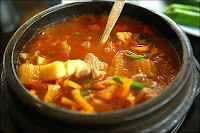Korea is widely known for its street food- it's quick, it's cheap, and it's downright delicious. The crowded street vendors will sell anything from kimbab (something akin to sushi rolls) to corn dogs to soondae (blood sausage). However, one of the most popular street foods has to be ddeokbokki, which is a spicy rice cake dish. Its bright red coloring can be intimidating for many foreigners, but the majority really aren't as spicy as they look.
Mama Lee's Ddeokbokki Recipe
Ingredients:
- 3 cups water
- 3 tbsp gochujang
- 2 tsp red pepper flakes (more or less depending on your spice tolerance)
- 1 tbsp soy sauce
- 1 tbsp sugar
- 1 tbsp corn syrup
- 2 tsp garlic, minced
- 1 tsp sesame oil
- 1 lb Ddukbokki ddeok (~ 25 3in pieces of rice cake)
- 1 sheet of fish cake (odeng)
- 1/2 cup cabbage
- 1 scallion and 1 tsp sesame seeds for garnish
Instructions:
- Soak the ddeok in warm water for approximately 30 minutes to allow them to soften.
- Over medium-high heat, combine everything from water to garlic in a large pan until the sauce is well mixed.
- Add in the softened ddeok
- Boil for another 8-10 minutes, stirring occasionally to prevent anything from sticking to the bottom of the pan.
- Add the fish cake and cabbage and boil for another 4-6 minutes.
- Add the sesame oil before removing the pan from the heat, and garnish with scallions and sesame seeds.
I understand that many individuals out there cannot handle even the slightest hint of spice. Because of this, it would be very difficult to enjoy the authentic ddeokbokki experience. However, fear not, because I discovered a fusion-style take on ddeokbokki for the heat-challenged that is actually becoming very popular in Korea. That style is the ddeokbokki carbonara. Now, this dish is probably not the best for anyone on a diet. However, if you wanted to try ddeokbokki but were worried about its spiciness, test out the following recipe and indulge yourself a little!
Ddeokbokki Carbonara Recipe
Ingredients:
- 1 lb of ddeok
- 2 tbsp of extra-virgin olive oil
- 4 strips pancetta (or bacon), chopped
- 1 1/4 cup milk
- 2 tbsp flour
- 1/4 cup onion, chopped
- 4 mushrooms, diced
- 2 cloves garlic, chopped
- 1/4 cup parmesan cheese, grated
- 1 egg
- 1 parsley
- Broccoli (optional)
- Black pepper
- Salt
- 1/2 tablespoon of gochujang (optional)
- Red pepper flakes (optional)
Instructions:
- Soak the ddeok in warm water for approximately 30 minutes to allow them to soften.
- Saute the onion and garlic in olive oil in a large skillet. Then add the pancetta (or bacon) until everything is browned.
- In a medium sized bowl, combine the milk and flour until smooth and thickened. Pour the milk mixture into the skillet.
- Add in the ddeok, mushrooms, cheese, broccoli, and parsley. If you want to add some heat to the dish, you may add gochujang and/or red pepper flakes at this point. Allow everything to simmer until creamy and well-combined. The mixture may get a little too thick, so add milk accordingly to thin it back down.
- Crack in an egg, mix it around, and remove from the heat.




















